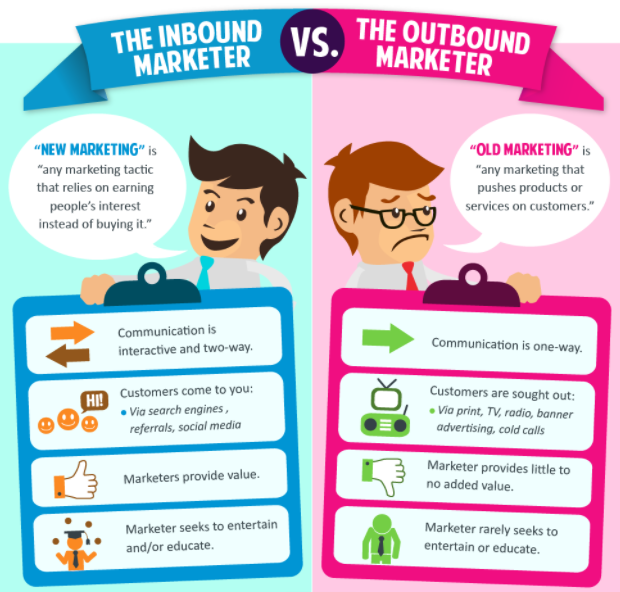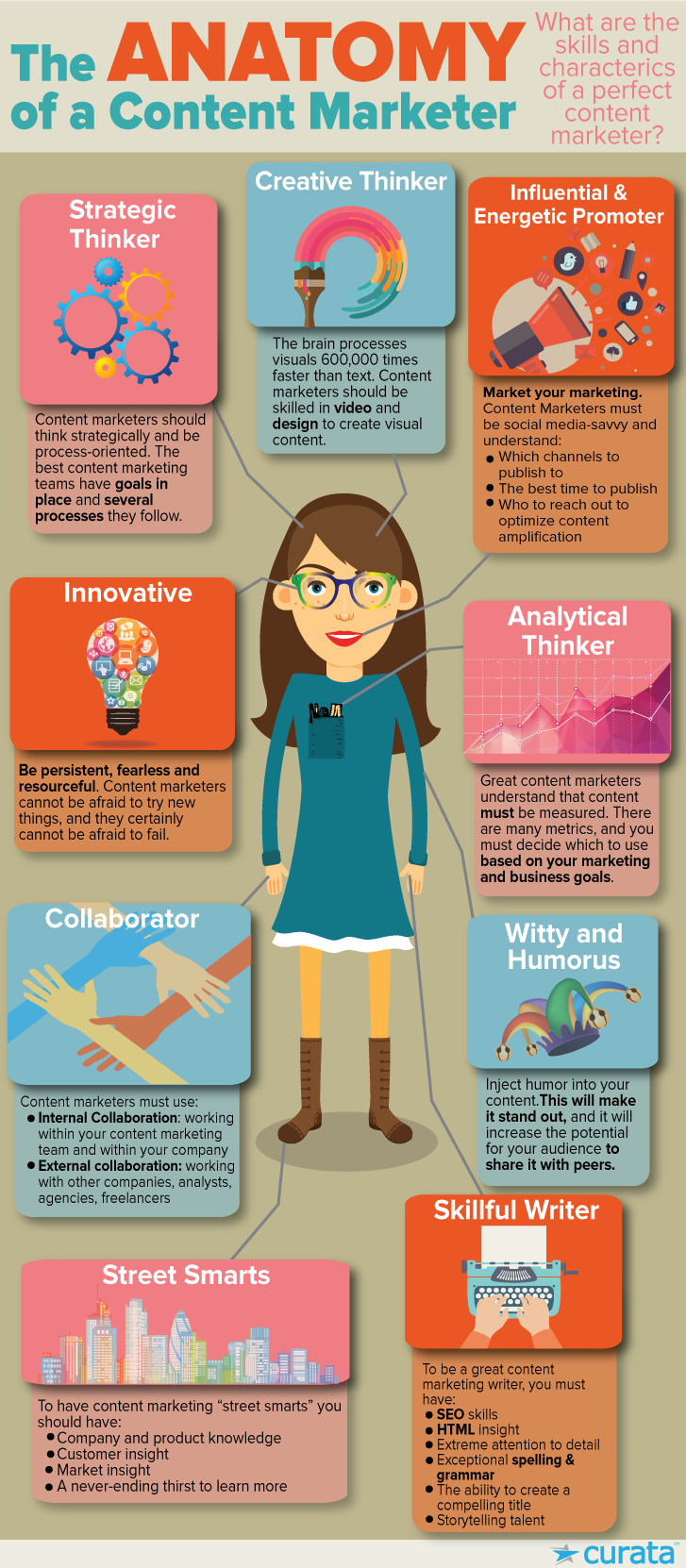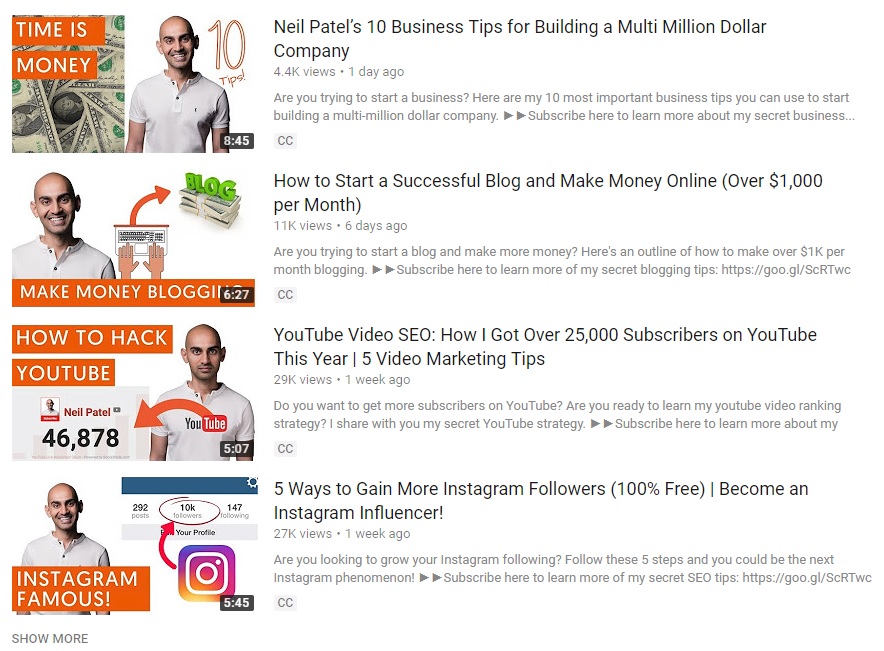Internet marketing is the most inexpensive way to reach your target market, regardless of the size of your business.
But what is internet marketing, really?
Defining Internet Marketing
Also called online marketing, internet marketing is the process of promoting a business or brand and its products or services over the internet using tools that help drive traffic, leads, and sales.
Internet marketing a pretty broad term that encompasses a range of marketing tactics and strategies – including content, email, search, paid media, and more.
These days, though, internet marketing is often used interchangeably with “content marketing.”
Why?
Because content marketing is the internet marketing of the present and future.
Content Marketing Institute defines content marketing as:
“A strategic marketing approach focused on creating and distributing valuable, relevant, and consistent content to attract and retain a clearly defined audience — and, ultimately, to drive profitable customer action.”
Think of it like this: content marketing (or inbound marketing) is in direct opposition to traditional advertising (outbound marketing), and in direct integration with the patterns and habits of today’s generation.
We don’t like to be sold to, we have our ad-blockers on, and we barely watch cable anymore.
Content marketing serves up content that addresses our pain points, and is there when we want it.
Here’s a great illustration of that from Voltier Digital:

Content Marketing vs. Traditional Advertising
Here’s the evolutional pathway behind the modernized form of marketing that is most successful today.
Selling no longer works (a.k.a., traditional advertising).
Why?
Traditional advertising focuses on pushing messages at the consumer to get them to buy.
It’s interruptive, obstructive, and intrusive.
It shouts, “Hey, look at me!” while waving its arms.
You may try to avoid eye contact, but traditional ads are persistent.
You know what traditional ads look like because you’re bombarded with them every single day.
Think TV commercials, billboards, magazine ads, radio ads, and web banner ads.

Ads have been around for a long time, as evidenced by this traditional ad for “honest-to-goodness” coffee from the 1950s.
Ads may still work in some strategic places.
But Internet users can just click away from ads if they don’t want to see them.
Which is exactly what happens.
According to a PageFair report, 615 million devices in use today employ ad blockers. Additionally, ad blocker use increased by 30 percent in 2016 alone.
You know it, I know it, everybody knows it.
Ads are annoying.
And, they aren’t the way consumers prefer to learn about new products anymore.
Instead of businesses shoving themselves in consumers’ faces, they need to take a different, gentler approach.
Content marketing is exactly that.
Brands and marketers who use it publish content that teaches, inspires, guides, or solves a problem for their target audience.
With some handy tricks, the targets can find that content on the web without it being pushed at them.
If the prospects gain something useful from the content, they’ll keep coming back for more.
Finally, consumers can interact with the brand organically and share their content on social media.
Trust is forged.
Authority is established.
Connections happen.
These loyal followers can then be converted into leads and sales – naturally.
All of the above happens with a focus on giving value to the user.
Help users – offer them value and they’ll reward you in return.
That is what internet marketing/content marketing is all about at its core.
Why Internet Marketing?
Now that you know what internet marketing is, you still may be wondering why there’s so much hype around it.
Well, the hype is totally founded.
Internet marketing has shown proven success over and over again.
Here are some stats gathered from around the web to help give you an idea of why internet/content marketing stands tall:
From my own content marketing endeavors, I have seen my small business take off.
With 99 percent of our focus on content marketing, we managed to grow our worth to millions of dollars.
Bottom line: This stuff works.
5 Content Examples: Providing Value for Big Returns
Reading about great content marketing is not enough to truly understand how it works. Instead, you have to see it in action to grasp its fundamental value.
Because when content is really good, it can do amazing things.
Here are some top examples of content types from brands who knocked content creation out of the park.
1. Blog Posts & Articles

One of the most common content types is blog posts and articles.
A blog, in particular, is a great content platform because it gives you a foundation for lots of posts, pages, and content that all point back to your site.
Think of a blog as a tree trunk. Your individual blog posts are the branches that reach out into the corners of the internet and search engines. Users can find your branches and follow them back to your core site. That gives you a greater shot at leads and sales.
For a great example of blogging content, look to Content Marketing Institute. They create troves of valuable, useful content for content marketers in order to teach, instruct, guide, or inspire.
The result?
Devoted fans, followers, and customers for their events, training, and consulting.
2. Infographics
Infographics are fun, visual ways to present valuable information.
They use charts, graphs, pictures, and illustration to explain concepts. This type of content is easily digestible and totally shareable.
Here’s a fantastic example of an infographic about baking bread from RJ Zaworski:

And here’s another highly-shared infographic from Curata about the anatomy of a content marketer:

3. Case Studies
Another popular and effective form of content is a case study.
In general, a case study is an in-depth look at some action your brand or business completed that had measurable results for success.
Usually, this translates into something you accomplished for a client.
Here’s a great example of a case study by Fractl:

In it, the agency showcases how they executed a successful content campaign for a real estate brand. They talk about how it came together, the “whys” of the project, and the results (presented in measurable stats).
This type of content is an awesome trust-builder for obvious reasons.
4. Podcasts
For those of you who shudder at the thought of writing a blog post or in-depth article or case study, there are content mediums out there for you.
Podcasts are huge.
They’re similar to the storytelling and news radio shows of yore, except people can download them and listen to episodes however and whenever they want.
If you are a good speaker or interviewer, this content format can be a great one for sharing valuable information with your audience.
For an example, check out Search Engine Journal’s Search Engine Nerds, about SEO, paid search, social media, and content marketing.
5. Videos
Videos are the hottest content type right now.
The stats are staggering. According to Social Media Today:
It’s easy to see why videos dominate.
Videos are simple to consume, they’re entertaining, and they appeal to the current attention-span deficit that we suffer from when we surf the web.
For a great example of a marketer making the most of video content, check out Neil Patel’s YouTube channel:

What You Need for Internet Marketing
So, you’re totally on-board for this internet marketing thing.
You love the idea of getting creative, sharing value with your prospects/audience, and building brand loyalty and customer relationships organically.
Hold on a second, though.
You can’t just jump into this blindly.
You need to understand the key pieces of successful internet marketing, first.
They include:
A Content Marketing Strategy
Content marketing without a strategy will ultimately fail – it’s just the sad truth.
You must have a direction, a plan, the right tools, and ways to measure your progress if you expect to get anywhere.
Here are the key content marketing strategy fundamentals involved:
- Goals. This is vital. You have to know where you want to go, and what success will look like for you (and you alone), before you can head down the road to get there.
- Your Brand Persona and Target Audience. When you eventually start creating content, you have to know who you’re talking to and tailor your brand voice to appeal to them uniquely. If you aren’t targeting the right audience (those people who will lean in to hear what you’re saying), you won’t find success. And, if you can’t find a way to stand out, you’ll blend into the hordes of other brands competing for attention in your industry.
- Keywords and Research. Once you know the why and the who, you have to address the how. How will you reach your audience? What do they want to learn, what problems do they need to solve? Research keywords to target to get found in search engine results, and find topics that have an inherent interest for your audience before you create any content.
- Content Focus and Commitments. What types of content will you create? How often will you post? Where will you post? You have to nail down these foundations so you can create content with consistency and quality.
- Content Creation. Once you have topics, keywords, a distinct voice, and a target audience, you can create content. However, if your content isn’t really good, you’re wasting your time. Get help if you need it, spend the time to tweak and perfect your output, and always put out the best content you can.
- Content Promotion. Your content will go much farther if you promote it the right ways. Promotion is even more effective if you plan when you publish your pieces, strategize about publishing on your blog and sharing on social media, and build up a community of followers who can help push your engagement over the top.
Search Engine Optimization (SEO)
When you use SEO with content marketing, it can take you farther, longer.
These two pieces together help power-up your organic (read: free) reach and visibility on the internet.
SEO encompasses a variety of techniques that help get you into prime spots on search engine results pages (SERPs). This means people can find you just by looking up some topic they’re interested in or need help with.
The overarching goal of good SEO is to get your site pages ranked on the first page of Google. (After all, most people rarely, if ever, click to Page 2 on their quest for information.)
Here are some basic SEO techniques that will help your content get indexed and ranked in search results:
- Strategically-placed keywords – You should place your target keyword in the headline, in subheaders, in the content, and in the meta description to help Google immediately pinpoint what it’s about.
- A well-designed, well-organized site – Google looks at how usable your site is, or how easy it is for people to click around, find what they’re looking for, and read your content.
- Clean page URLs – The URL structure for your pages shouldn’t be gibberish (i.e. http://yourdomain.com/blog/content123xyz-asdfkla). They should be simple and easy to read (i.e. http://yourdomain.com/blog/how-to-do-seo).
Of course, this is just bare-bones SEO. To get a better, in-depth look, check out SEJ’s ebook SEO 101: Learn the Basics of Search Engine Optimization.
A Boost from Paid Methods
Organic search can give you great click-through rates. It also gives you the benefit of the inherent trust people have in Google results.
However, sometimes investing in paid search can give you a boost.
Here are some good examples from Search Engine Land:
- Use paid search to remarket to visitors who found your site through organic search, and tailor ads for them based on their experience.
- Test different versions of ad copy (A/B testing) to see which performs better – then use what you learned for your landing pages on your site.
- Paid search can increase your visibility in ways that organic search cannot, such as giving you air-time for high-volume keywords for which you’d have a hard time organically ranking.
The combination of paid search and content marketing gives you a cohesive internet marketing whole.
Organic and paid traffic can merge to net you higher visibility and better results for driving traffic, which can increase your leads and sales.
Patience & Fortitude
Content marketing requires some pieces that are far less tangible than strategy or SEO, but are perhaps the most important.
When it’s truly successful, content marketing is a long-term strategy.
It takes time to start seeing the ROI from your content efforts.
The blog post you publish today will not pay off by tomorrow, next week, or even next month.
Instead, you must have the patience and fortitude to wait months – maybe even up to a year or longer – to start seeing the returns.
The good news?
Content marketing is internet marketing that builds momentum over time. HubSpot calls this phenomenon “compounding.”
High-quality content gets increased visits over time. This helps build the page’s authority, and can increase its reach through the ways people interact with the content as they discover it.
Think linking, sharing, engaging, and more.

Most importantly, all of these compounding returns can help your content climb the Google ranks, which in turn helps it reach more people organically.
Pretty soon, your hard work on that post starts paying off in spades.
It doesn’t happen right away, but it will happen if you set up your content for success, with strategy.
It just takes patience and fortitude to see it through, and to keep putting out content with the months ahead in mind.
What Now? How to Dive into Internet Marketing
By now, you may be hopping with excitement about this thing called content marketing.
You want to dive in, like right now.
If you’re ready and raring to go, here’s what to do next:
1. Pace Yourself & Set Goals
Remember, this is a marathon, not a sprint.
Pacing yourself is essential to doing it right – otherwise, you’ll start spinning your wheels, and burnout will be inevitable.
Instead, take stock of where you are in your business.
Think ahead to where you want to go in the next year.
- Do you already have customers?
- Do you have a website?
- Are you starting from square one?
Pick up a pen and paper, or settle yourself in front of your computer, and start formulating some goals for content marketing.
Make your goals achievable (but not too easy), and make them measurable.
Need some guidance about goals?
Here are some tips from CMI on setting goals, including how to tie them to key performance indicators (KPIs).
For ideas about goals to reach for, read this article from Copyblogger on 10 Content Marketing Goals Worth Pursuing.
2. Secure Your Content ‘Home Base’
For content creation, lead gathering, and more, you need a home base on the web.
This is:
- Where your content will live.
- What you’ll link to when you share your content on social.
- Where you’ll gather leads from the traffic you pull in.
If you don’t have a website, start researching options.
If you have a website, make sure it’s optimized, user-friendly, and organized by following SEO and usability best practices.
3. Start Strategizing
Now that you have goals, a home for your content, and enthusiasm, it’s time to surge ahead with the rest of your content marketing strategy.
We’ve already discussed strategy, but here are the actionable steps that make it work:
6 Key, Actionable Steps for Content Strategizing
- Target audience research and brand persona development
- Keyword research and SEO opportunity research
- Topic ideation and content planning
- Creating/writing/producing content
- Community building and nurturing
- Sharing and promoting content on social channels
This is a broad list. Each step has its own set of actions and planning involved.
It’s important not to skip any steps. Each is vital for winning at content marketing.
Yes – this takes time, effort, planning, patience, fortitude, and teamwork to get it all done.
Once you get your internet marketing rolling, though, just one piece of content in your arsenal can have an impact like this:

And that’s just what one piece of content can do.
Imagine if you started up a consistent, quality content publishing schedule and built your cache of content assets.
The possibilities are unreal.
…But only if you’re ready to roll up your sleeves and get your hands dirty.
Dig in, plot your course, get creative, build relationships, and enjoy the internet marketing of today.
It’s different from what you’re used to – it has a beating heart.

But that’s a great thing.
More Content Marketing Resources:
Image Credits
In-Post Photo #1: Voltier Digital
In-Post Photo #2: Flickr
In-Post Photos #3-4, #7-8: Screenshots taken by Julia McCoy, January 2018
In-Post Photo #5: RJ Zaworski
In-Post Photo #6: Curata
In-Post Photo #9: HubSpot
In-Post Photo #10: Express Writers
Subscribe to SEJ
Get our daily newsletter from SEJ’s Founder Loren Baker about the latest news in the industry!
